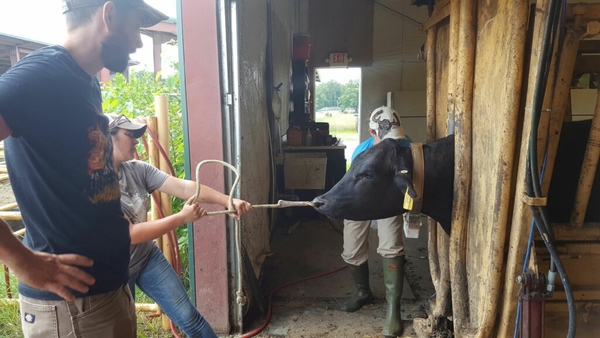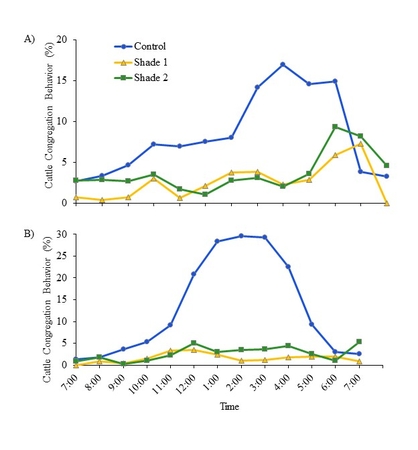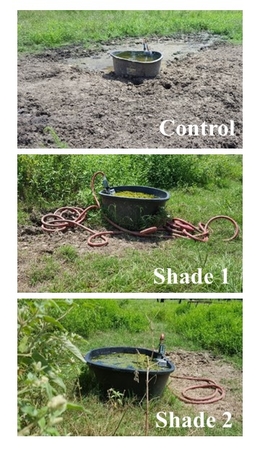Shade for livestock has been cited as one of the top reasons for establishing silvopastures (Orefice et al. 2017). One of the many benefits of shade for cattle production is that access to shade has been shown to limit the amount of time cattle spend congregated around their water troughs (Schütz et al. 2010). Minimizing the time cattle spend congregated around water troughs can reduce soil compaction around the water trough, decrease damage to watering equipment, and mitigate wasting water. While this concept has been demonstrated using artificial shade structures, there is currently limited information about the benefits of natural tree shade for limiting cattle congregation behavior around water resources. As cattle typically prefer natural tree shade to artificial shade structures (Zuo and Miller-Goodman 2004), silvopastures may combine the benefits of shade with various additional ecological benefits such as enhancing wildlife habitat, soil conservation, and water quality.
To evaluate whether access to tree shade would decrease cattle congregation behavior around water troughs, a two-year study was conducted at the University of Arkansas at Monticello in the summers of 2017 and 2018. One control pasture and two shade treatment pastures, each measuring roughly four-acres, were used in this study. The control pasture contained no trees. The first shade pasture contained 30 trees concentrated mostly at the northeast corner of the pasture. The second shade pasture contained 32 trees dispersed throughout the pasture to create several small clusters of shade trees within the pasture. Each year, 15 bred Beefmaster cows (Bos indicus) were used to create three herds of five cows. Each herd was randomly assigned to a pasture at the beginning of each summer. The herds were rotated between the three pastures at 28-day intervals for three months to allow each herd access to each pasture once during the summer.
Cattle congregation behavior around the water troughs was evaluated using GPS-collars. GPS-collars provide a novel way to conduct continuous long-term evaluations of cattle movements and behaviors without the need for direct observations (Anderson et al. 2013). Two cows in each herd were outfitted with Lotek GPS 3300LR radio-collars (Lotek Wireless Inc., Ontario, Canada) set to record a GPS location every 30 minutes for the duration of each summer (Figure 1). The accuracy range of the GPS-collars used in this study was about 20 feet. The location of the water troughs in each pasture was mapped using handheld GPS units, and a 30-foot radius buffer zone was digitally established around each water trough using ArcGIS® 10.3. Cattle congregation behavior was calculated as the hourly percentage of GPS-collar locations located within the 30-foot buffer zone around the water trough in each study pasture from 7:00am to 7:00pm during each month.
 Figure 1. Amanda Foust and field technicians Melissa Butler and Richard Vaerewyck outfitting a cow with a GPS-collar to continuously monitor cattle congregation behavior around water troughs at the beginning of the summer in 2018.
Figure 1. Amanda Foust and field technicians Melissa Butler and Richard Vaerewyck outfitting a cow with a GPS-collar to continuously monitor cattle congregation behavior around water troughs at the beginning of the summer in 2018.
During both years, cattle in the control pasture spent significantly more time congregated around their water trough from 12:00pm to 4:00pm than cattle in both shade pastures (Figure 2). In 2017 cattle in both shade pastures exhibited an average of 72% less congregation behavior around water troughs during the mid-day hours than cattle in the control pasture. In 2018 cattle in both shade pastures exhibited an average of 88% less congregation behavior around their water trough during the mid-day hours than cattle in the control pasture. There was also more damage to water equipment and more visible soil compaction around the water trough in the control pasture compared to both shade pastures during both years (Figure 3).
 Figure 2. Average hourly percentage of cattle congregated around water troughs in the control pasture with no shade trees and both shade tree pastures (shade 1 and shade 2) during the summer in A) 2017 and B) 2018.
Figure 2. Average hourly percentage of cattle congregated around water troughs in the control pasture with no shade trees and both shade tree pastures (shade 1 and shade 2) during the summer in A) 2017 and B) 2018.
 Figure 3. Area around water troughs in the control pasture with no shade trees and both shade tree pastures (shade 1 and shade 2) at the end of the summer in 2017.
Figure 3. Area around water troughs in the control pasture with no shade trees and both shade tree pastures (shade 1 and shade 2) at the end of the summer in 2017.
This two-year study suggests that the presence of trees in cattle pastures can be beneficial to livestock management systems and pasture health. When given access to shade trees, cattle exhibited less congregation behavior around their water troughs, resulting in less observed soil compaction around the water troughs and less necessary maintenance to water equipment. Conversely, cattle without access to shade trees spent more time congregated around their water trough, leading to more soil compaction around the water trough and more damage to water equipment causing major leaks and wasting water. Anecdotally, cattle without access to shade trees were also observed to exhibit more aggressive behavior while congregated around the water trough. This increase in aggressive behavior could have contributed to the increased damage to water equipment in the control pasture.
References
Anderson DM, Estell RE, Cibils AF (2013) Spatiotemporal cattle data – a plea for protocol standardization. Positioning 4:115-136. doi: 10.4236/pos.2013.41012
Orefice J, Carroll J, Conroy D, Ketner L (2017) Silvopasture practices and perspectives in the northeastern United States. Agroforest. Syst. 91:149-160. doi: 10.1007/s10457-016-9916-0
Schütz KE, Rogers AR, Poulouin YA, Cox NR, Tucker CB (2010) The amount of shade influences the behavior and physiology of dairy cattle. J. Dairy Scr. 93:125-133. doi: 10.3168/jds.2009-2416
Zuo H, Miller-Goodman MS (2004) Landscape use by cattle affected by pasture developments and season. J. Range Manage. 57:426-424. doi: 10.2111/1551-5028(2004)057\[0426:lubcab\]2.0.co;2


